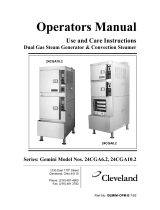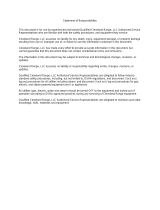
5
B. KEYPAD TIMER CONTROL PANEL
(1) Cooking Operations – Keypad Control Panel
For safe, efficient operation of the steamer, the operator must, at a minimum, comply with all
cautions, warnings and instructions in the detailed operating procedures and be familiar with the
control panel shown in Figure 2-2. The operator must be familiar with all the operating features
explained in this manual before attempting to operate the steamer.
(2) Manual and Timed Modes
The steamer has two operating modes: manual and timed. The TIMED/MANUAL rocker switch
selects the operating mode. Pressing the MANUAL end of the switch selects the manual-operating
mode. Pressing the TIMED end of the switch selects the timed (automatic) operating mode.
a. Manual Mode
The manual mode provides continuous steaming. The operator starts and stops steaming
operations manually. See the Operating and Cooking Procedure – Manual Mode in Section 4,
Part B for more information.
b. Timed Mode and Use of the Timer
1. Timer Use and Temperature Compensation
•
The keypad timer control starts and stops steaming operation, and monitors cooking
time and compartment temperature for accurate, efficient, uniform steam cooking.
•
The keypad control uses a temperature compensation circuit that effects only the timer.
When operating, the timer ONLY COUNTS DOWN WHILE THE COOKING
COMPARTMENT IS AT COOKING TEMPERATURE. This provides totally automatic
control of the steaming operation and assures uniform cooking as the timer
automatically compensates for food product defrosting and/or compartments heat up
time. Whenever the steamer is not at cooking temperature 193°F, the timer pauses and
the display shows “PAUS”, once temperature is reached a digital display of the
remaining time is displayed. When the timer counts down to zero a buzzer will sound, to
indicate that cooking is complete and the steam generator will shut down.
•
The timer will operate similarly when the steamer is being operated in the manual mode
including counting down only when the steamer is at cooking temperature, except that
the timer does not start or stop the steaming cycle.
2. Timer Operation
a) Setting the Timer
To set the cooking time, the timer must first be zeroed. The timer can be set only when
the cooking time display is clear (00:00). The cooking time display contains four digits.
The left two digits are minutes, and the right two digits are seconds. The display 12:34 is
set for 12 minutes and 34 seconds. To set the cooking time:
1) Change the required cooking time to minutes and seconds.
2) Press the number keys for minutes, and then, for the seconds.
3) If the cooking time is 99 seconds or less, only press the number keys for seconds.
b) Starting/Stopping the Timer
Press the START/STOP key to start or stop the timer. When the START/STOP key is
pressed, the steam generator begins heating the water to steam. Shortly, steam fills the
cooking compartment.
1) The timer display reads “PAUS” until the cooking compartment reaches proper
cooking temperature, or when the timer cycle is paused by pressing the
START/STOP key again after the timer has started.
2) When the cooking compartment reaches proper cooking temperature, the timer
display shows the count down.
NOTE: A timer setting of 10 minutes may in fact take 11 or 12 minutes (or even longer,
if the unit was not preheated prior to the start of the cooking cycle) for the timer
to count down and the alarm to sound. This is normal. Heating the compartment
and food to cooking temperature uses the additional time.

























